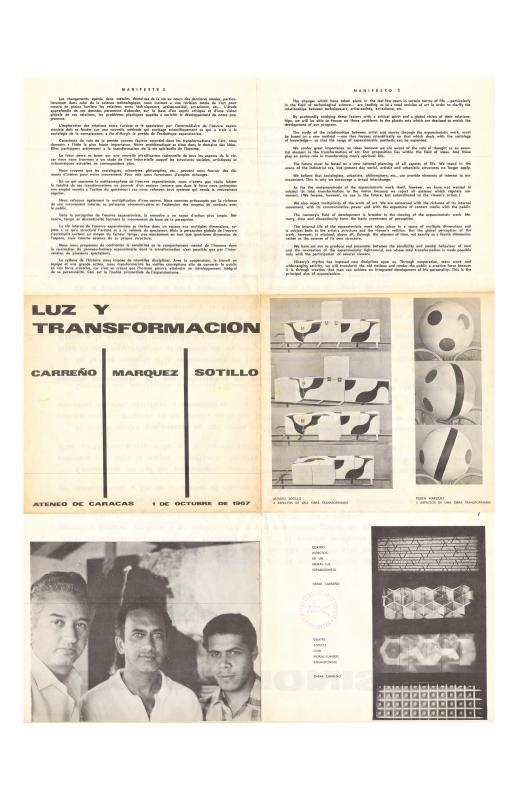This manifesto was published on the occasion of Grupo Expansionista’s first exhibition in Venezuela. The group was headed by the painter and sculptor Omar Carreño (1927–2013), and the other members were Andrés Guzmán (b. 1931), Rubén Márquez (b. 1927), and Alirio Oramas (b. 1924). The exhibition, which was held at the Museo de Bellas Artes in Caracas in 1967, was a formal challenge to the Venezuelan visual arts and a call for a new approach to art and its relationship to life. The expansionist agenda championed the idea of a flexible form of art that could be modified by the viewer thanks to an unprecedented blending of two- and three-dimensional supports and the use of new materials and technologies. Carreño had been working in this vein since 1951, when he produced his earliest manipulatable works in Paris and exhibited them there the following year. He continued to experiment with this concept throughout the 1950s and, on his return to Venezuela, organized meetings with artists and intellectuals to consolidate the expansionist movement. Those efforts finally bore fruit in 1967 when this exhibition was presented and this manifesto was published. In the meantime, however, Carreño had published this text in Rome, in 1966, when he took up his art project again, convinced that conventional Kinetic alternatives were becoming exhausted. Imitating the style of all avant-garde manifestos, this one spells out what the movement intended to break away from; in this case, that meant two-dimensional, static, figurative works of art. This manifesto also expresses the group’s commitment in terms of what they intend to produce, and how, which moves the art and political manifesto genres a little closer together thanks to its emphasis on the transformation of existing structures.
The proposal to create centers for collaborative initiatives in several places reflects the movement’s universal goals, as does its use of the manifesto genre as a vehicle for the communication of ideas. The group’s use of cybernetics and other new technologies reflects their commitment to the “expansion” of art media; it is also in synch with the series of urban events that were organized in Venezuela during the 1960s, including the Parque Ferial de El Conde and other Kinetic productions orchestrated by Alejandro Otero, Gego, and Carlos Cruz-Diez. It should be noted that, a decade earlier, in 1957, Carreño had produced a large mobile sculpture in the interior of the country, at Plaza Municipal de Pariata.
Grupo Expansionista published a second manifesto that same year, 1967, at the Ateneo de Caracas. The following year, Carreño published a third manifesto on the same subject as part of an exhibition at the Galería Número in Venice. In 2008, the Caracas branch of the Galería Durban Segnini presented an exhibition of expansionist works by Venezuelan and international artists, curated by Carreño and Luis Miguel Molina, in celebration of the movement’s fortieth anniversary in Venezuela.
Regarding the group’s second manifesto, see “Expansionismo: Manifiesto 2” [doc. no. 1157254]; for thoughts on the visual language developed by Omar Carreño, see the essay by Víctor Guédez “La construcción de lo visual en Omar Carreño” [doc. no. 1157401]; and for an interview by Teresa Alvarenga with the artist, see “Llegó el momento de decir: Omar Carreño lo hizo primero” [doc. no. 1157657].



